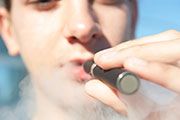Article
E-Cigarettes Encourage Adolescent Progression to Tobacco
Author(s):
Investigators found that among adolescents that began as never users, e-cigarette users were more likely to become experimental, infrequent or frequent combustible cigarette users.

Adding to a growing body of research on the effects of e-cigarette use, a new study suggests that adolescents who use electronic nicotine delivery systems increase their odds of subsequent use of combustible cigarettes in some capacity.
“E-cigarette use has been associated with subsequent initiation of combustible cigarette use in many studies both in the United States and throughout the world,” said lead study author, Jessica L. Barrington-Trimis, PhD, assistant professor of Preventative Medicine at the Keck School of Medicine, University of Southern California. “However, there has been less research on patterns of cigarette use beyond initiation.”
E-cigarettes a battery-operated devices that are used to inhale an aerosol that usually contain nicotine, flavorings (such as cherry or cinnamon), propylene glycol and glycerin. Since they were introduced to the market only 11 years ago, research on the health effects of e-cigarettes are still in its infancy stage. While e-cigarettes have less chemicals than combustible cigarettes, they still contain nicotine, which is addictive, plus carcinogens and other toxic chemicals, according to the National Institutes of Health.
The Centers for Disease Control and Prevention (CDC) has also reported that between 2011 and 2017, e-cigarette use increased among middle and high school students. For middle school students, use grew from 0.6% to 3.3%. High schooler use increased from 1.5% to 11.5%.
Participants for this study included subjects from The Southern California Children’s Health Study (CHS), Happiness and Health Study (H&H), and the Yale Adolescent Survey Study. Adolescents in grade levels ranging between ninth and twelfth grades, self-reported, at baseline, as “never users,” “ever users,” “experimenters,” “infrequent users,” or “frequent users” of tobacco products. Those groups were then divided into those that used combustible cigarettes, e-cigarettes, or both within the previous 30 days.
Investigators found that among adolescents that began as never users, e-cigarette users were more likely to become experimental (OR = 4.58; 95% CI: 3.56 - 5.88), infrequent (OR = 4.27; 95% CI: 2.75 - 6.62) or frequent (OR = 3.51; 95% CI: 1.97 - 6.24) combustible cigarette users.
“We also found that cigarette smokers at baseline were more likely to remain cigarette smokers (without or without concurrent e-cigarette use) than transition to exclusive e-cigarette use or non-use of either product,” said Barrington-Trimis.
Few adolescents smoked more than 5 days within the previous 30 days, so researchers were unable to closely examine progression to daily smoking. The studies were also regionally-based, so it is not clear how these findings apply to other populations in the US.
“We need to understand whether there are certain characteristics of e-cigarettes — or certain types of e-cigarettes – that make it more or less likely that a non-smoking youth will experiment with cigarettes or an already smoker will be able to transition off of cigarettes to e-cigarettes or no nicotine use,” said Barrington-Trimis.
The study, “E-cigarette use and Subsequent Smoking Frequency Among Adolescents,” was published online in Pediatrics.




